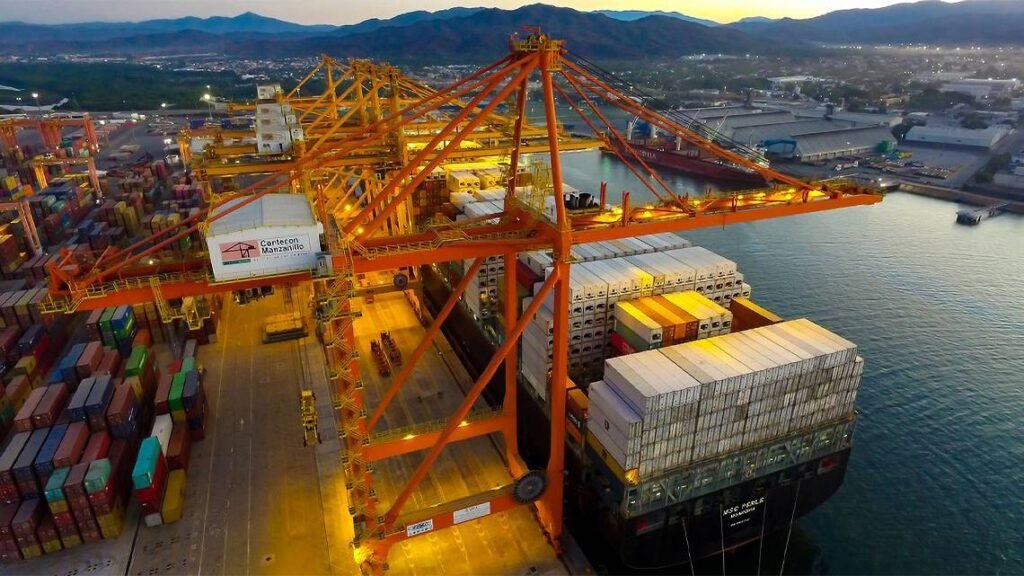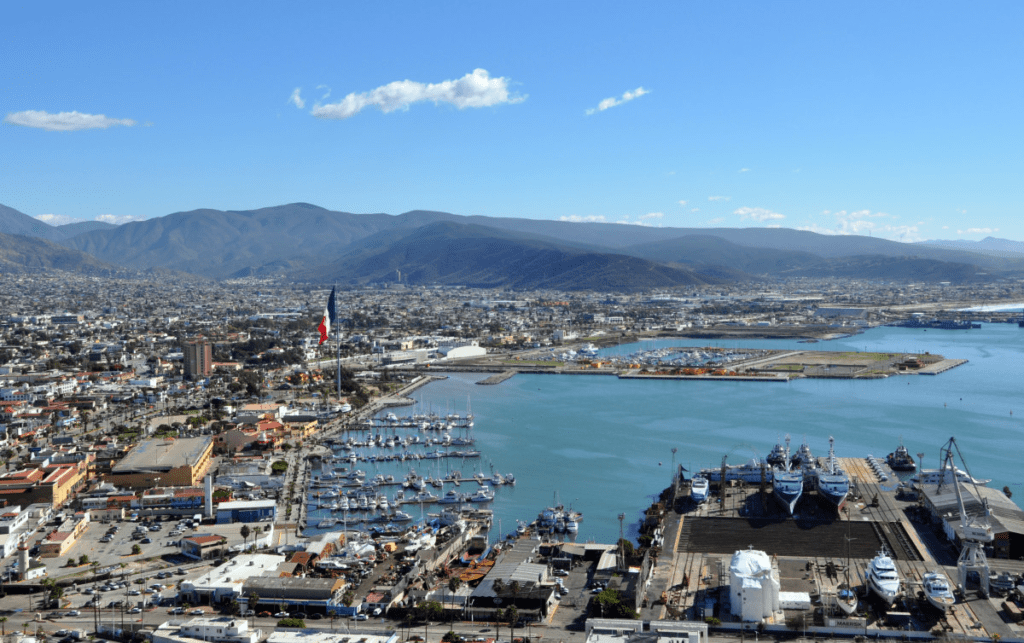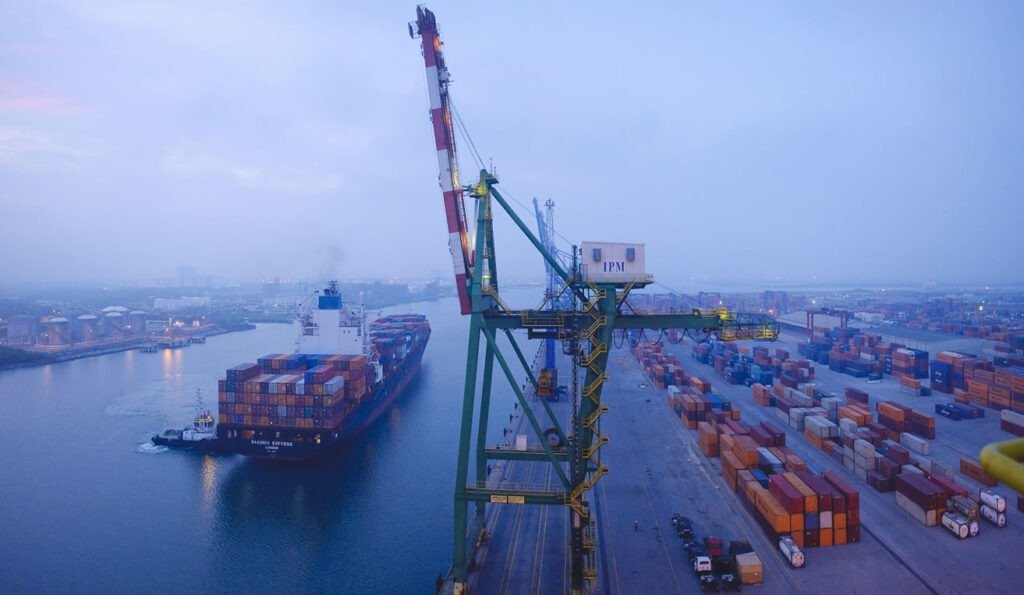Ports in Mexico are famous among seafarers. Mexico is situated in the southern part of the North American continent and stands as the tenth most populated country globally. As a developing economy, it has been classified as an upper-middle-income country by the World Bank and holds the position of the second-largest economy in Latin America.
Boasting a rich cultural heritage, Mexico is home to numerous UNESCO World Heritage sites. The leading sectors contributing to its economy include financial services and tourism, followed by automobile manufacturing, oil production, electronics industries, and agriculture.
Surrounded by the Pacific Ocean and the Caribbean Sea, Mexico features over 20 seaports along its Atlantic coast and approximately 12 on its Pacific Coast and approximately 10 Major Ports in Mexico
10 Major Ports in Mexico
1. Port of Manzanillo

The Port of Manzanillo is a seaport located in Manzanillo, Colima, Mexico, on the west coast of the country. It is one of the busiest ports in Mexico, responsible for handling Pacific Ocean cargo for the Mexico City area. The port was established in 1971 and has since grown to become a significant part of Mexico’s maritime infrastructure. Some key aspects of the Port of Manzanillo include:
- Location: The port is situated in the state of Colima on the west coast of Mexico.
- History: The modern port of Manzanillo was established in 1971, and the government of Mexico created the National Commission for Port Coordination to improve the port’s productivity and efficiency.
- Geography and Economic Impact: The port is located in a strategic position, with easy access to the Pacific Ocean and the Mexico City area. It handles a variety of cargo, including general consumer goods, agricultural products, minerals, and exports to countries such as the United States, Canada, Guatemala, Colombia, Chile, Japan, China, India, Malaysia, and Singapore.
- Manzanillo Container Terminal: The port also has a container terminal, which is a significant part of its operations.
- Dominican Republic Rehabilitation Project: The Port of Manzanillo in the Dominican Republic is undergoing a rehabilitation project, which aims to expand the port’s capacity and functionality. The project is designed to be developed in three stages, with completion by 2045. The future port is expected to channel mainly container traffic, solid bulks, and liquid bulks (petroleum products and liquefied natural gas (LNG).
By 2045, it is estimated that the port will have a total potential port traffic of up to 13.0 million tons and 1.5 million TEUs
2. Port of Lazaro Cardenas

The Port of Lázaro Cárdenas is a significant deep-water seaport located in Lázaro Cárdenas, Michoacán, Mexico. It is a major hub for handling various types of cargo, including containers, dry bulk, and liquid cargo.
The port features both public and private terminals specialized in different types of cargo, such as grain, multi-use, containers, minerals, fluids, coal, and fertilizers. With its strategic location along the main maritime trade routes of the Pacific coast, the port plays a crucial role in Mexico’s maritime trade. It is also known for its deep waters, with depths of up to 18 meters, making it an important port for large vessels.
The port is owned by the Port Authority of Lázaro Cárdenas and has a significant annual cargo tonnage, with a high volume of vessel arrivals. The port’s infrastructure and capabilities position it as a key player in the region’s trade and logistics network.
3. Port of Ensenada

The Port of Ensenada is a significant marine freight and cruise terminal located in Ensenada, Baja California, Mexico. It is a deepwater port situated in Bahia de Todos Santos and serves as a vital hub for various types of ships, including those arriving from major ports in Asia, North America, and South America.
The port handles a diverse range of cargo, including bulk cargo, container ships, and cruise ships. In addition to its commercial activities, the port also supports specialized shipyards and commercial and sport fishing. The Port of Ensenada is a key contributor to the region’s economy, with substantial annual cargo tonnage and passenger traffic.
It is also a popular destination for cruise ships, with a significant number of cruise tourists visiting the port annually. The port’s influence extends to its connectivity with several marine shipping routes, linking Baja California with various destinations, including other Mexican ports, the United States, and international locations such as Japan and China.
The port’s largest revenues are derived from cruise shipping and commercial fishing. Ensenada is also known for its vibrant tourist attractions, including its beautiful beaches, boutiques, and restaurants, making it a popular destination for cruise passengers and tourists.
4. Port of Mazatlan

The Port of Mazatlán is a significant cruise and marine freight terminal located in Mazatlán, Sinaloa, Mexico. As a cruise ship passenger, you will find that the port is the northernmost city to visit on the Mexican Riviera, offering a charming area with a range of activities, including miles of beaches, deep culture, and delicious seafood.
The modern terminal is staffed with helpful volunteers, and the surrounding city is known for its authentic welcome to visitors. Mazatlán is also recognized as a sportfishing mecca and is home to the country’s largest fleet of shrimping boats, making it the shrimp capital of the world.
Also Read, Most Fatal Boating Accidents – Why, Causes & Precautions
The port is equipped with a cruise vessel terminal, which serves as a hub for cruise ship arrivals and departures, offering various services to accommodate cruise passengers. The terminal is located approximately 1 mile (1.6 kilometers) from Old Mazatlán, allowing for easy access to the historic old town via the scenic seaside malecón.
The port’s influence extends to its connectivity with several marine shipping routes, making it a vital part of the region’s maritime infrastructure.
5. Port of Veracruz

Founded by the Spanish Conquistador named Hernan Cortes in the 15th century, the city of Veracruz has transformed into an important financial centre and a trading hub.
The Port of Veracruz is the oldest and largest port in Mexico, located on the Gulf of Mexico in the Atlantic Ocean. It is a strategic hub for trade between Mexico and the world, handling a diverse range of cargo.
The port has undergone significant expansion and modernization, with the construction of new docking positions and the implementation of first-rate infrastructure and equipment. The expansion is expected to generate a substantial number of direct and indirect jobs.
The port is a vital transportation center and an important fishing port, with a significant impact on the local and national economy. It is also a key hub for international car companies with factories in the region. The Port of Veracruz is a major contributor to Mexico’s maritime trade and plays a crucial role in the country’s import and export activities.

It contains 11 wharves covering 4500 m, handling diverse cargo such as corn, petroleum coke, wheat, soya, containers, steel, metal scrap, vegetable oil, rice, tallow, benzene, canola, pig iron, clinker, automobiles, machinery, chemicals etc.
The principal port on the eastern coast of Mexico, is the backbone of the city’s economy.
It is also an important fishing port and also provides water sports facilities. People from all over the world flock to the city to enjoy the Carnaval, an annual festival featuring colourful parades, local food, dance and music.
6. Port of Guaymas

The Port of Guaymas is a significant marine freight and cruise terminal located in Guaymas, Sonora, Mexico, on the Gulf of California. It is a regional port with a large area of influence, serving the states of Sonora, Baja California Sur, Chihuahua, and Sinaloa, as well as the geographical area of central/southwest of the United States. Some key aspects of the Port of Guaymas include:
- Location: The port is situated NNW of Guaymas Bay on the east coast of the Gulf of California1.
- History: Guaymas was established in 1769, and its port became one of the most important in northwestern Mexico in the 19th century. The port has undergone significant expansion and modernization, with the construction of new docking positions and the implementation of first-rate infrastructure and equipment.
- Connectivity: The port is 1.8 km (1.1 miles) from the federal four-lane highway No. 15 and forms part of the “The city of Nogales is located to the north and is on the border of the U.S.”.
- Hinterland and Foreland: Guaymas has maintained its regional port status, serving both national and international trade.
- Port Activity: The port’s main commitment is to provide safely and efficiently the port services of fiscal storage and logistics in the management of exterior commerce.
- Exports: Among Guaymas’ chief exports are copper, sulfuric acid, and wheat, as well as various other crops grown in the hinterland, such as cotton, fruits, and vegetables.
- Tourism: The city is known for its sportfishing, with sailfish, marlin, yellowtail, and other species found in the area. Resort developments along the Gulf of California north of the city, especially at San Carlos, are transforming Guaymas into a major tourist destination.
The Port of Guaymas is a vital part of Mexico’s maritime infrastructure, contributing to the region’s economic development and international trade relations.
7. Port of Tampico

The Port of Tampico is a significant seaport located in Tampico, Tamaulipas, Mexico, on the Gulf of Mexico. It is one of the main ports on the east coast of Mexico, serving as an entry and exit point for various types of cargo, including mining products, petrochemicals, steel, wood, and other industrial products.
The port is equipped with modern infrastructure and equipment, including docking positions, cranes, and storage facilities, to handle a diverse range of cargo. It is also an oil, commercial, and military harbor. The Port of Tampico is owned and operated by the Port Authority of Tampico S.A. de C.V.

The port’s location on the Gulf of Mexico makes it an important hub for international trade, with connections to other ports in the region.
It is an important commercial and military harbour consisting of 24 berthing facilities. Drydocks and shipyards are located on the southern bank of the river including 2 tanker terminals operated by the Pemex company.
Tampico has 6 private and 2 public terminals and 10 fields for constructing marine oil rigs. It has ample storage space including 38,000 m2 of warehouse area, 6500 m2 of sheds and 330,000 m2 of open yards for storing general cargo.
8. Port of Altamira

The Port of Altamira is a significant seaport located in Altamira, Tamaulipas, Mexico, on the Gulf of Mexico. It is situated 21 km north of Tampico and covers 85% of the total economic activity within a 550 km influence radius. Some key aspects of the Port of Altamira include:
- Location: The port is situated in the State of Tamaulipas, 21 km north of Tampico.
- Size: The total land area of the port is 11,736 hectares.
- Infrastructure: The port has access to infrastructure services, water resources, road, and railway access. It is designed to receive ships with high tonnage and high volumes.
- Main Private Petrochemical: The Port of Altamira is home to the main private petrochemical company in the country and has experienced significant development.
- Maritime Terminal: The Maritime Terminal Altamira is located in Altamira, Tamaulipas, Mexico,
- Altamira Terminal Portuaria: This terminal is located in Altamira, Tamaulipas, Mexico
It has a large modern container terminal consisting of 4 docks. However, it mainly serves the region’s petrochemical sector and contributes to job creation and revenue generation.
Companies like BASF and POSCO have processing plants near the port facility.
9. Port of Coatzacoalcos
This port lies at the mouth of the Coatzacoalcos River before it flows into the Gulf of Mexico. It is the main oil port of the nation having a natural harbour divided into two portions; a free port lying on the western bank of the river and the Pajaritos oil port owned by Pemex company.
An important port and a transportation centre, Coatzacoalcos is linked to the Mexico metropolitan area and Merida by railways.
It primarily exports petroleum products manufactured in Minatitlán followed by forest products, agricultural goods and consumer goods. The port’s liquified gas terminal contains 7 wharves for accommodating gas carriers and oil tankers. It also has storage facilities for bulk, containers and general cargo.
It has 8 conventional berths, and 9 tanker berths and handles 1,350 vessels carrying 29,220,000 tonnes of cargo annually.
Also read, Carnival cruise Ship overboard Accidents – Why?
10. Port of Topolobampo

The Port of Topolobampo is a seaport located in the state of Sinaloa, Mexico, on the Gulf of California. It is situated approximately 365 km northwest of Mazatlán1. The port is the beginning of an international trade corridor, “La Entrada al Pacifico,” which ends near the Midland-Odessa, Texas area.
Some key aspects of the Port of Topolobampo include:
- Location: The port is situated in the state of Sinaloa, on the west coast of Mexico, approximately 365 km northwest of Mazatlán.
- History: Topolobampo was founded in 1884 by Albert K. Owen and was initially a utopian colony inspired by Henry George’s economic ideas.
- Cruise Port: The port is also a cruise port, located in the Gulf of California within the state of Sinaloa.
- Coordinates: The port’s coordinates are 25°36′20″N 109°03′0″W.
- Elevation: The port is located at an elevation of 10 meters (30 feet).
- Population: The port is the fourth-largest town in the municipality of Ahome, with a 2010 census population of 6,361 inhabitants.
- Railway: The port connects the northern Mexican states through the Chihuahua-Pacific Railroad, which has a terminus in nearby Los Mochis.
- Car Ferry: Topolobampo is the eastern port for the daily car ferry connecting to La Paz in Baja California Sur.

Hence, crops like wheat, soy, sorghum, vegetables, and fruits comprise the majority of exports followed by livestock. It has 4 private terminals for handling general cargo, containers, oil products, LPG and ammonia.
Topolobampo has more than 10 berthing facilities and 5 fishing wharves covering 600 m with an alongside depth of 6 m for accommodating fishing vessels.
Approximately 1000 ships, 4,850,000 tonnes of cargo and 185,000 passengers are handled at this port annually.
You may also like,

